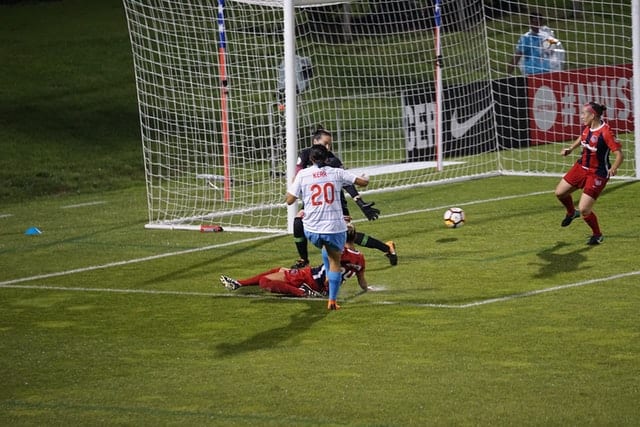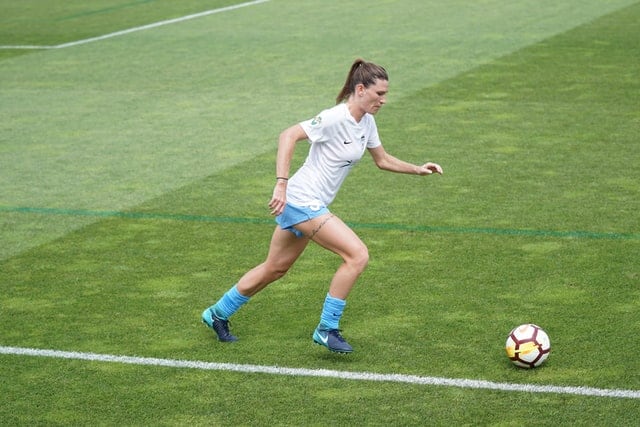When you hear the word “Winger” as a soccer fan/player, one of the first things that come to your mind is a “a player who makes a lot of assists”.
Wingers in soccer are known for their ability to make great runs on the far sides of the field in order to cross the ball to the striker of the team.
However, another important job from a winger is to score goals. Wingers are not just supposed to cross the ball towards whoever is inside the penalty area. The wingers are also required to score goals, especially the forward wingers.
But how do they do that? If you are a winger, and you want to be able to score more goals, then this article will give you some tips to help you do that.
To score more goals as a winger, you need to work on improving your agility skills, head to the penalty area when the ball is on the other side of the field, learn how to handle the ball with both legs, win more often during 1v1 scenarios and much more.
If you don’t know why you would need any of the things mentioned above, then the rest of the article will go through them one by one and explain why each and everyone of them is needed to score more goals as a winger in soccer.
Without any delays, here are some tips that might help you score more goals as a winger in soccer:
1- Kick the ball towards the opponent’s goal more often.
At first, this might sound like the most obvious tip one could ever give. However, if you are a soccer winger, then you know what I mean.
As a winger in soccer, the main thing that comes to your mind whenever you have the ball is “I should cross the ball to the striker as soon as I get the chance to”.
Whenever they are at either side of the field, wingers are almost always looking for someone to cross the ball to.
However, if they don’t find any strikers that they can cross the ball to, then they should not be afraid of moving towards the penalty area and attempting to score a goal themselves.
In simple words, just don’t be afraid to kick the ball towards the opponent’s net.

In fact, to score more goals, you just need to shift your mentality from “finding the right person to cross the ball towards”, to “finding the best scoring opportunity for your team”.
The best scoring opportunity might be you attempting to score a goal yourself instead of giving the ball to someone else to score.
To sum this up, just give yourself more attempts to score goals instead of always crossing the ball towards the penalty area even if none of your teammates are in a good position to score.
Now that you have shifted your mentality, the next question becomes: how do you ACTUALLY score the goals that you intend to score? That’s what the rest of the tips are for.
2- Work on your agility skill
Having great agility in soccer is fundamental no matter what position you play at.
As a winger, your agility skills can help you make instant changes in your running direction, and these instant changes can help you trick the full back defender that is attempting to block your attack.
Usually, the full back defender of your opponent is expecting you to keep running alongside the touchline of the field, and then make your move when you reach the corner.
However, if you use your agility skills to instantly change your running direction and run deeper towards the penalty area, then you might be able to trick the full back defender and put yourself in a great open space to score.
If you haven’t worked on your agility skill yet, you should start working on it as soon as possible.
3- Head to the penalty area more often.
According to a study done on the goals scored in 5 world cup competitions, most of the goals scored in these competitions were scored from inside the penalty area.
The study claims that only 14.6% of the goals were scored from outside the penalty area.
In other words, if you want to be able to score more goals, you need to kick the ball towards the goal from inside the penalty area more often.
If you run towards the penalty area more often, you will instantly multiply your chances of scoring a goal by a lot.
But as a winger, you need to know when to run towards the penalty area without the ball. After all, a winger’s job is to be available at the sides of the field when they are needed.
If you always stay inside the penalty area of your opponent, then you aren’t a winger anymore. So what’s the right balance?
Well, the trick is to move closer to the penalty area of your opponent whenever the ball is on the other side of the field.
For example, if you are a left winger, and the ball is on the right side of the field, then you could move towards the penalty area in order to receive the ball from whoever has the ball on the right side of the field.
If the right winger manages to cross the ball to you and if you manage to score from that cross, then it will be a winger assisting a winger. How cool is that?
Jokes aside, whenever you are not needed on the sides of the field, you should try to move closer towards the opponent’s goal in order to increase the scoring chances of your team.
During a cross, the more teammates inside the penalty area, the better.
To sum this section up, move towards the penalty area of your opponent more frequently, but make sure not to forget your roles as a winger. In other words, find the balance that best works for your team.
4- Work on your weak leg.
Not a lot of soccer players are blessed with the ability to maintain the same performance when playing on the different sides of the field. The main reason behind that is because most of the soccer players have a leg that is stronger than the other one.
It’s all about muscle memory. If you use your right foot more often when you play soccer, then that’s the leg that you want to use whenever you’re kicking the ball because that’s the stronger leg.
However, that doesn’t mean that you shouldn’t learn how to kick the ball with enough force and accuracy using your weak leg. In fact, if you want to score more goals as a winger, that’s exactly what you should do.
But why?
Here’s why. Let’s say that your right foot is your strong foot in soccer. Naturally, you will be playing as a right winger because you want to use your right foot to cross the ball towards your team’s strikers.
But let’s say that you follow the previous tip mentioned in this article, and you head towards the penalty area whenever the ball is being crossed from the other side of the field.
Which foot will you be able to use in this scenario? Your left foot, and that’s why you need to make sure that your left foot kicks are strong and accurate enough or else you’ll miss more chances.
Sure, you can just score with a header when the ball is crossed towards you, but not all of the crossed balls are high balls. Some of these balls are low and require just one instant kick towards the goal.
I have fallen into this trap a lot of times, especially when I played mini soccer on a small pitch. My left foot kick was weak and inaccurate. I lost a lot of goal scoring opportunities just because I wasn’t able to hit the ball correctly whenever someone crossed the ball towards me from the other side of the field.
As I worked on my left foot, I was able to convert more crosses into goals.
The main take away from this is that as a winger, you need to make sure that you are capable of kicking the ball with enough force and accuracy using your weak foot, because this is the foot that you are going to use whenever the ball gets crossed towards you from the other side of the field.
5- Improve your one-on-one encounters.
This is going to be the last tip in this article, but that doesn’t mean that it’s less important than the others. In fact, this one could be on the top of the list.
Wingers should know how to handle one on one situations very quickly and very smoothly.
Let’s talk about midfielders for a second. Midfielders can always just keep passing the ball among each other until they get a great chance to pass the ball towards a forward player and put them in a great position to score.
In other words, they can always choose to avoid one-on-one situations with their opponents by simply passing the ball to someone else.
This is a luxury that a winger might not always have. As a winger, you are the frontline of your team. You are the player who is supposed to penetrate the opponent’s defense by running straight forward and by heading directly towards your opponent’s goal line without any hesitation.

As you can very easily guess, your opponent’s defense won’t just let you pass without causing you any troubles.
Usually, whenever you start your run towards the goal line of your opponent, you’ll find the full back of your opponent waiting for you.
If you can instantly beat the full back of your opponent during a one-on-on encounter with them, then you might give yourself enough free space to be able to score a goal yourself, or cross the ball towards a teammate who is in a better position to score.
In other words, even if you aren’t aiming to score more goals as a winger, working on your one-on-one skills is essential.
Having good agility is one of the first steps in winning one-on-one encounters with your opponent, but there’s more to it than just having good agility.
One thing you can do to work on your one-on-one skills is to just play soccer with only one friend.
Find a very small soccer field, and find a friend who is willing to play a 1v1 match with you. The game is simple. Each one of you is supposed to score a goal by surpassing the other player and kicking the ball inside the net.
The whole game will be an exercise that can teach you how to surpass a defender as quickly as possible.
With that said, I will end my article here. Here’s a quick summary of what you have just read.
SUMMARY
If you want to score more goals as a winger, do the following:
- Move towards the penalty area of your opponent when the ball is on the other side of the field
- Practice your 1v1 encounters with your opponent
- Work on your agility skill
- Work on your weak leg
- Attempt to score more often instead of always choosing to cross the ball.

